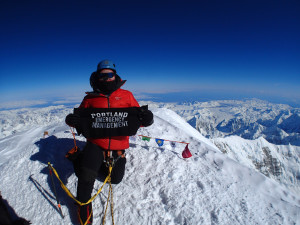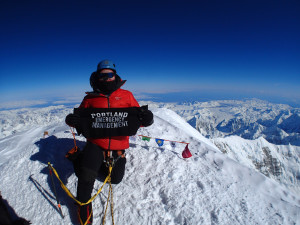
Sixty years after first successful Everest ascent, US mountaineers develop appropriate high altitude toilet technology.
August 19, 2013
by Abby Brown
It’s been 60 years since climbers first summited Mount Everest. Around 3,500 people have made it to the top so far, and that number doesn’t include climbers and Sherpas living at lower base camps. But what has become strikingly clear in the 21st century is that people are leaving behind a mess. Time Magazine states “the mountain has become a trash heap.” National Geographic describes how garbage is leaking out of glaciers and “pyramids of human excrement” are littering high camps. And NPR highlighted mountaineer Conrad Anker’s efforts to clean up Everest. With all of this sh*t literally accumulating on Everest, it begs one to ask “could this same fate affect mountain peaks of the Pacific Northwest?” PHLUSH caught up with local mountaineer and Portland Bureau of Emergency Management (PBEM) employee Dan Douthit to get some answers.
Douthit first started climbing at Mount Hood in 2008, and has since climbed most of the large Cascade volcanoes. His biggest climb to date is Mount McKinley, the highest mountain in North America. Douthit says “The summit is a great bonus, but for me it is all about getting to experience the landmarks of the Pacific Northwest in a different way.” He has a lot to say about managing sh*t on mountaintops, and he hopes that the Pacific Northwest can lead the way for better sanitation management in other places around the world.
“When you stay for multiple nights on a mountain problems can arise in regards to sanitation,” says Douthit. When he started climbing, he was exposed to the Leave No Trace Mountaineering movement. His guide company told him to pack out his sh*t in small bags. Rangers for Mount Shasta and Mount Adams will actually give you a blue bag for packing out your sh*t when you buy your permit. It’s very important for climbers to do this because traditional bury-methods do not work in these high-alpine environments. “Anything that you leave will eventually melt out,” adds Douthit. “It leaves a horrible mess, and it gets into the snow that people have to use for their drinking water.”
Denali presented entirely new challenges for Douthit’s climbing career. He was on the mountain for 18 days, and the sanitation tactics were different. One ranger named Rodger Robertson started a program to promote Clean Mountain Cans, and all climbers on Denali are required to use one of the 1,100 cans on loan. Douthit says they are pretty easy to use. It’s a small bucket with a screw-on lid and strap for a backpack. Inside the can, there are small bags to hold human excrement. Full bags are thrown into crevasses. Douthit believes this crevasse policy could change in the near future when people on the mountain increase.
When asked about the sanitation situation on other Pacific Northwest peaks, Douthit says “People are generally respectful. I’ve seen urine sometimes spread around camping areas, but generally in my experience the Cascades are okay. The only ones it’s been a problem on are probably Rainier and Shasta where there are larger camp areas. The two main climbing routes on Rainier (Disappointment Cleaver and Emmons) have outhouses at high camps so that helps. The other mountains, maybe once or twice, I’ve seen something. But it’s nothing like the stories you hear about in the Himalayas or the Andes.”
Douthit thinks the Clean Mountain Can could possibly work in other locales, but there needs to be more information about locations of crevasses and available funding to start such programs. He even feels that if this particular technology will not work, there could be other similar programs. He says “the status quo in the Himalayas is not acceptable to the climbing community.”
There is an upcoming conference in Alaska to talk about such issues called the Sustainable Summits Conference from September 8th to 11th. Perhaps the Pacific Northwest really can lead the way in creating more sustainable summits worldwide?

